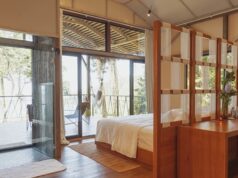ATLANTA—Design firm Perkins+Will announced that its Atlanta office earned LEED Platinum with 95 points awarded, the most of any project in the Northern Hemisphere to date under the 2009 version of LEED for New Construction.
“Perkins+Will has designed a showpiece building,” said Rick Fedrizzi, president, CEO and founding chair of the U.S. Green Building Council (USGBC). “1315 Peachtree Street exemplifies the kind of environmentally sustainable measures that can be taken during a building retrofit. It has earned its high LEED score and will continue to pay dividends through energy saving measures for decades to come.”
The office building, originally constructed in 1985 and located in the heart of Midtown Atlanta, across from the High Museum of Art, has been redesigned into a high-performance sustainability-focused building. Perkins+Will purchased and began renovating the structure in 2009. The firm wanted to showcase its commitment to the environment and the transformative power of sustainable design by incorporating building re-use and renovation efforts into the concept of sustainability. In addition to LEED Platinum, the project is already a recipient of the Urban Land Institute’s Development of Excellence Award.
Mayor Offers Congratulations
“As Mayor of the city, I am proud that Atlanta is home to the highest LEED score of any building in the Northern Hemisphere at this time,” said Mayor Kasim Reed. “Perkins+Will’s LEED Platinum office building shows what happens when true innovation in design, sustainability and reuse come together. This designation further underscores Atlanta’s commitment to becoming a top 10 sustainable city in the United States. I applaud Perkins+Will on their achievement.”
Perkins+Will’s Atlanta office occupies the top four floors of the mixed-use building. In line with one of the project’s goals of supporting the greater community of Atlanta, other tenants include The Museum of Design Atlanta (MODA)—its presence made possible by infilling what was once the building’s parking deck—and the Peachtree Branch of the Atlanta-Fulton County Public Library.
“We set out to make 1315 Peachtree a living model of sustainability and we have been inspired by the results so far,” said Willard Lariscy, Perkins+Will principal and managing director. “A 95-point LEED Platinum Certification is another confirmation that we’ve accomplished our goals, but since it’s a living lab, we’ll continue to create new goals as we adapt to change and experiment with new ideas.”
Reducing energy use and increasing efficiency were key to the building’s design. Exterior renovations include more energy efficient exterior glazing and alterations to the front facade. An exterior terrace on the fifth floor serves as lunch, meeting and office social space. It also features a garden for employees to get their “green” thumbs dirty.
Innovative Interior Space
The interior represents the latest in workplace design, encouraging collaboration through office-wide wifi network access, computational nodes, collaborative benching-style workstations and multipurpose team rooms with transparent walls that can be easily reconfigured to incorporate the largest amount of input from all staff.
The building is equipped with raised flooring and a radiant heating and cooling system, the first of its kind in Atlanta. It utilizes passive sun shading on lower levels and an active, dynamic exterior sunshade on the building terrace level to control afternoon sunlight and heat gain. The building’s design also incorporates views and natural daylight in virtually every occupied space. Lighting control strategies such as daylight harvesting and reduced ambient lighting coupled with the use of LED lamps also reduce the building’s energy needs.
Microturbines and an adsorption chiller on the building’s roof are part of a trigeneration system. By using natural gas to produce electricity, the building’s carbon footprint is reduced by 68 percent to comply with the 2030 Challenge for reduced greenhouse gas emissions. And in Atlanta, where water availability has become an important issue, a 10,000 gallon cistern catches rainwater that is then filtered, treated and re-circulated for landscape irrigation and low-flow urinals and toilets.
All of these initiatives together have helped the building cut energy consumption by 58 percent and municipally supplied potable water use by 78 percent. Perkins+Will reused, repurposed, recycled or otherwise diverted 80 percent (630 tons) of material from the building. Perkins+Will was able to connect with 19 local nonprofit groups, and match their needs for furniture and materials with their inventory of items salvaged from the existing space. This experience spawned the Lifecycle Building Center, which is now a nonprofit resource for repurposing salvaged material for future work in the region.
Go to Perkins+Will.







